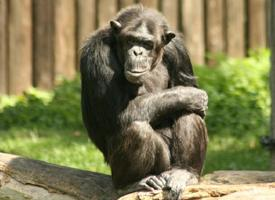
Weights and measures
| Height at the shoulder | from 65 to 95 cm |
|---|---|
| Weight | from 44 to 75 kg |
State of endangerment
| Endangered |
Animal description
The chimpanzee (Pan troglodytes), often simply called the chimp, is a species of great ape native to the forests and savannahs of tropical Africa. It is a member of the Hominidae family, which also includes humans, gorillas, and orangutans. Chimpanzees are distinguished by their large ears, dark to light brown hair, and, in adults, a bare face except for a short white beard in both males and females. Adult males can weigh between 40 to 70 kilograms (88 to 154 pounds), while females are generally lighter, weighing 32 to 47 kilograms (70 to 104 pounds).Chimpanzees are known for their remarkable intelligence and complex behaviors. They are capable of using tools, such as sticks to fish for termites or leaves to scoop water. This evidence of tool use and manufacture is a significant aspect of their culture, which is passed down from generation to generation. Their social structure is equally complex, characterized by a fission-fusion society where groups form and dissolve depending on the availability of food and mates. These groups are highly hierarchical, led by an alpha male whose position is maintained through alliances with other males and sometimes females.
Communication among chimpanzees is multifaceted, involving a rich repertoire of vocalizations, facial expressions, and body language. Their vocalizations include pant-hoots, grunts, and screams, each serving specific social functions, from maintaining group cohesion to expressing emotions such as excitement or aggression. Facial expressions and gestures are equally important, used in close-range interactions to convey a range of emotions and intentions.
Chimpanzees are omnivores, with a diet that includes fruits, nuts, seeds, leaves, and occasionally small animals and insects. Their foraging behavior is highly adaptive, allowing them to exploit a wide range of food resources in their environment. This adaptability extends to their use of habitat; while primarily arboreal, spending much of their time in trees, they are also comfortable on the ground where they travel on all fours using a knuckle-walking technique.
The life span of a chimpanzee in the wild is about 40 to 50 years, though individuals in captivity can live longer, with some reaching over 60 years of age. Females reach sexual maturity around 13 years of age and typically give birth to a single offspring after a gestation period of about eight months. The mother-infant bond is particularly strong, with offspring depending on their mothers for both care and learning essential survival skills for the first few years of life.
Chimpanzees share more than 98% of their DNA with humans, making them our closest living relatives alongside bonobos. This genetic similarity has led to significant interest in studying chimpanzees to gain insights into human evolution, behavior, and diseases. However, this close relation has also made them subjects of medical research, a practice that has raised ethical concerns and calls for better protections.
Unfortunately, chimpanzees are currently listed as an endangered species, facing threats from habitat destruction, poaching, and diseases. Deforestation and the expansion of agricultural land reduce their living space, while hunting for bushmeat and capture for the illegal pet trade deplete their populations. Conservation efforts are in place to protect these remarkable creatures, including habitat preservation, anti-poaching measures, and sanctuaries for orphaned and rescued individuals. The survival of chimpanzees is crucial, not only for the maintenance of biodiversity but also for the insights they offer into our own species and the natural world.
Map of occurrence

Similar Animals
New photos of animals
Top 10 animals
- Dolphin gull (Leucophaeus scoresbii)
- Diana monkey (Cercopithecus diana)
- Moustached guenon (Cercopithecus cephus)
- Galápagos tortoise (Geochelone nigra complex)
- Japanese macaque (Macaca fuscata)
- Stone loach (Barbatula barbatula)
- Russian tortoise (Testudo horsfieldii)
- Greek tortoise (Testudo graeca)
- Common flying dragon (Draco volans)
- Vendace (Coregonus albula)


